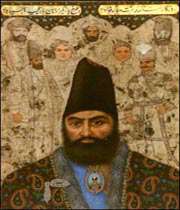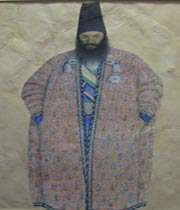Background and Achievements of Amir Kabir
Part 1

Amir Kabir was born into a lowly household at Hazaveh in the Farahan district. His father, Karbala?i Mohammad Qorban, entered the service of Mirza Abu'l-Qasim Farahani Qa'im Maqam of Farahan as cook, and when Mirza Bozorg was appointed chief minister to ?Abbas Mirza, the crown prince, in Tabriz, Karbala?i Qorban accompanied him there, taking his son with him. Amir Kabir first assisted his father in performing domestic duties in the household of Mirza Bozorg, who saw signs of unusual talent in him and had him study with his own children. After he had learned reading, writing, and some mathematics, Amir Kabir, still an adolescent, was appointed by Mirza Bozorg to supervise his stables, a function he performed with exemplary efficiency. Mirza Bozorg died in 1237/1822 and was succeeded in the post of minister to the crown prince by his son, Mirza Abu’l-Qasem Qa?em-maqam. Under his aegis Amir Kabir entered government service, being appointed first to the post of lashkarnevis [military registrar] for the army of Azerbaijan. In 1251/1835, he was promoted to the position of mostofi-ye nezam, becoming responsible for supervising the finances of the army of Azerbaijan; several years later he was put in charge of the same army’s provisions, financing, and organization with the title of vazir-e nezam.
During his tenure, Amir Kabir participated in many missions abroad, he spent almost four years in Erzurum, participating in the work of a commission to delineate the Ottoman-Iranian frontier and settle certain other differences between the two states. He appears to have been the most forceful member of the Iranian negotiating team, resisting attempts to exclude Mohammareh (present-day Khorramshahr) from Iranian sovereignty and to make Iran pay compensation for its military incursions into the area of Solaymaniyeh. In this he acted almost independently of the central government in Tehran, which not only failed to formulate a consistent policy vis-à-vis the Ottomans but also opposed most of Amir Kabir’s initiatives. Although a form of treaty was concluded between Iran and the Ottoman state, the borders had still not been delineated when the Crimean War erupted and the British and Russian mediators found themselves at war and withdrew. Amir Kabir nonetheless acquired first-hand knowledge of the procedures of international diplomacy and of the aims and policies of Britain and Russia with respect to Iran. This helped him in the elaboration of his own distinct policies toward the two powers when he became chief minister.
Moreover, his years in Erzurum fell in the period of the Ottoman military and administrative reforms known as the Tanzimat. Some awareness of these reached Amir Kabir in Erzurum and inspired in him at least one aspect of his policy as chief minister: the elimination of clerical influence upon affairs of state. When explaining to the British consul at Tabriz in 1265/1849 his own determination to make the authority of the state paramount, he said, “The Ottoman government was able to begin reviving its power only after breaking the power of the mullas”.
Amir Kabir returned to Tabriz in 1263/1847. A year later, while retaining the post and title of vazir-e nezam he was appointed lala-bashi or chief tutor to the crown prince Naser-al-din, who was still only fifteen years of age.
Soon after, in SHawwal, 1264/September, 1848, Mohammad Shah died, and Naser-al-din had to proceed to Tehran and assume the throne. But his minister, Mirza Fathallah Nasir-al-molk ?Aliabadi, was unable to procure the necessary funds, so Naser-al-din had recourse to Amir Kabir, who made the necessary arrangements. Naser-al-din’s confidence in Amir Kabir increased, and shortly after leaving Tabriz, he awarded him the rank of amir-e nezam, with full responsibility for the whole Iranian army. After arriving in Tehran, he also appointed him chief minister (shakhs-e avval-e Iran), with the supplementary titles of amir-e kabir and atabak (?u’l-qa?da, 1264/October, 1848). The former title came to be his common designation; the latter, used for the first time since the Saljuq period, referred to the tutorial relationship between the minister and his young master, reflecting, perhaps, Amir Kabir’s view of himself as a semi-independent agent.
His appointment as the chief minister aroused resentment in various persons who thought themselves more deserving, particularly the queen mother and other wasteful princes, who evidently resented Amir Kabir’s proud and self-confident bearing and his clamp down on their excess spending and allowances. The intrigues of his opponents resulted in a mutiny of a company of Azerbaijani troops garrisoned in Tehran, demanding his removal and execution; but with the cooperation of Mirza Abu’l-Qasem Emam-e Jomeh of Tehran, who ordered the merchants of Tehran to close the bazaar and arm themselves, the mutiny was soon quelled, and Amir Kabir resumed his duties.
More severe disorder prevailed in a number of provincial cities, especially Mashhad. Toward the end of the reign of Mohammad Shah, Hamza Mirza Heshmat-al-doleh had been appointed governor of Khorasan, but he found his authority disputed by Hasan Khan Salar, who, with the help of some local chieftains, had rebelled against the central government (1262/1846). Hamza Mirza abandoned Mashad to Hasan Khan and fled to Herat. Amir Kabir sent two armies against Hasan Khan, the second of which, commanded by Soltan Morad Mirza, defeated his forces and captured him. Amir Kabir had him executed (1266/1850), together with one of his sons and one of his brothers, a punishment of unprecedented severity for such provincial resistance to central authority, and a clear sign of Amir Kabir’s intention to assert the prerogatives of the state.

With order reestablished in the provinces, Amir Kabir turned to a wide variety of administrative, cultural, and economic reforms that were the major achievement of his brief ministry. His most immediate success was the vaccination of Iranians against smallpox, saving the lives of many thousands if not millions.[3] Faced with an empty treasury on his arrival in Tehran, he first set about balancing the state budget by attempting to increase the sources of revenue and to decrease state expenditure. To aid him in the task, he set up a budgetary committee headed by Mirza Yusof Mostofi-al-mamalek that estimated the deficiency in the budget at one million Iranian toman. Amir Kabir thereupon decided to reduce drastically the salaries of the civil service, often by half, and to eliminate a large number of stipends paid to pensioners who did little or no governmental work. This measure increased his unpopularity with many influential figures and thus contributed to his ultimate disgrace and death.
At the same time he strove to collect overdue taxes from provincial governors and tribal chieftains by dispatching assessors and collectors to every province of the country. The collection of customs duties, previously farmed out to individuals, was now made the direct responsibility of the central government, and the Caspian fisheries, an important source of revenue, were recovered from a Russian monopoly and contracted out to Iranians.
The administration of the royal lands (khalesajat) came under review, and the income derived from them was more closely supervised than before.
Yield and productivity, not area, were established as the basis of tax assessment for other lands, and previously dead lands were brought under cultivation. These various measures for the encouragement of agriculture and industry also benefited the treasury by raising the level of national prosperity and hence taxability.
Of particular interest is the care shown by Amir Kabir for the economic development of Khuzestan (then known as ?Arabestan), identified by him as an area of strategic importance, given its location at the head of the Persian Gulf, and also of potential prosperity. He introduced the planting of sugarcane to the province, built the Naseri dam on the river Karkheh and a bridge at Shushtar, and laid plans for the development of Mohammara. He also took steps to promote the planting of American cotton near Tehran and Urmia.
Among the various measures enacted by Amir Kabir, the foundation of the Darolfonun[3], in Tehran was possibly the most lasting in its effects. Decades later, many parts of this establishment were turned into the University of Tehran[4], with the remaining becoming Darolfonun Secondary School. The initial purpose of the institution was to train officers and civil servants to pursue the regeneration of the state that Amir Kabir had begun, but as the first educational institution giving instruction in modern learning, it had far wider impact. Among the subjects taught were medicine, surgery, pharmacology, natural history, mathematics, geology, and natural science. The instructors were for the most part Austrians, recruited in Vienna by Da?ud Khan, an Assyrian who had become acquainted with Amir Kabir during the work of the Ottoman-Iranian border commission. By the time the instructors arrived in Tehran in Moharram, 1268/November, 1851, Amir Kabir had already been dismissed, and it fell to Da?ud Khan to receive them. Mirza Aqa Khan Nuri, Amir Kabir’s successor, sought to persuade Naser-al-din Shah to abrogate the whole project, but the Darolfonun, soon became a posthumous monument to its founder. The Austrian instructors initially knew no Persian, so interpreters had to be employed to assist in the teaching; but some among them soon learned Persian well enough to compose textbooks in the language on various natural sciences. These were to influence the evolution of a more simple and effective prose style in Persian than had previously existed.
Source: wikipedia.org